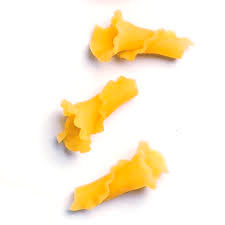The BFIA macaroni & cheese recipe
The bfia macaroni and cheese recipe steals from a number of sources, not least Edna Lewis and Scott Peacock, and Jasper White, but also Elizabeth Raffald and Eliza Acton, a demonstration as if that were needed that the old ways can be good ways. The Raffald receipt appeared in 1769, the Acton in 1845, both in books from London. About six servings.

- ¾ lb short curly or ridgy pasta (elbows of course are traditional but see the Notes)
- 3 or 4 Tablespoons unsalted butter
- a handful of cured pork; pickled pork (recommended), salt pork, guanciale, pancetta, tasso, bacon or the like.
- a minced onion
- 2 Tablespoons flour (preferably Wondra)
- generous 2½ cups milk
- cayenne
- a little salt and lots of pepper
- about ½ teaspoon mace
- 1 Tablespoon dry mustard (like Colman’s)
- 2 or 3 Tablespoons Worcestershire
- ½ cup crème fraiche or sour cream
- ½ cup heavy cream
- ¾ lb assorted shredded (the largest holes of a box grater will do) hard cheeses including a sharp Cheddar; others may be Cheshire, Lancashire, White Stilton, Wensleydale or foreign interlopers of your choice ( but see the Notes)
- about ¾ cup chopped scallion greens
- another ¼ lb sharp Cheddar
- about 1 cup breadcrumbs
- butter to dot the breadcrumbs
- Cook the pasta for half the time specified on its container, shock it with cold water in a colander and drain it.
- Melt the butter in a big heavy skillet over medium low heat until it bubbles, then add the cured pork dice.
- Cook to render the fat from the pork, reducing the heat if necessary to prevent scorching the meat.
- Remove the pork from the skillet and replace it with the onion, stirring as needed to prevent it from browning, until it softens. That will not take long.
- Whisk the flour into the fat until the mixture becomes uniform and smooth, then gradually pour on the milk in small amounts until each new batch of sauce thickens in turn.
- Reduce to the lowest possible heat and simmer the sauce at the merest burp for about 30 to 40 minutes. The sauce should have become extremely thick.
After the sauce has simmered for about 20 minutes, preheat the oven to 375 °.
- Grease an ovenproof dish of appropriate size--the pasta should not sit more than about 1 ½ inches deep--and dump the pasta into the dish.
- Return the pork to the skillet and add the cayenne, salt, pepper, mace, mustard, Worcestershire, crème fraiche and heavy cream.
- Once the sauce has remarried to the new ingredients, stir in the first, bigger batch of cheese until it just begins to melt, then immediately pour it over the pasta and mix everything together.
- Top the mixture with the remaining cheese followed by the breadcrumbs, then dot them in turn with a generous dose of butter.
- Bake the macaroni & cheese until it bubbles and browns, usually in 30 to 40 minutes.
Notes:
-Absent access to cured pork for cooking, you could use diced cooked ham or even hot dogs (fun!) cut into thinnish rounds. If you do, increase the initial amount of butter to a solid 6 Tablespoons and add the meat at Step 8 instead of Step 2.
-Although macaroni & cheese originated in England--broad consensus holds that the first recognizably modern recipe appears in The Experienced English Housekeeper , a London imprint from 1769--we take considerable liberties from the traditional choice of elbow macaroni. Something with a more baroque shape holds the dish together and fosters a more varied texture ranging from soft to crunch for the finished product. Our favorite for the purpose is campanelle, which resemble smashed trumpets. Other options include cavatappi, mafalda, radiatroe, totini and trottole.
-Whenever possible we stray even further from tradition and substitute half inch cubes of fresh mozzarella for one of the hard cheeses within the dish.
-Most recipes, taking a cue from Mrs. Raffald, bind the dish with a white sauce. Edna Lewis and Scott Peacock, however, use a custard reinforced with a little flour instead and their version, from The Gift of Southern Cooking , is very good indeed, along with just about every other recipe in the book. Buy it. We have taken the mace (although they specify nutmeg; mace is more traditionally English), mustard, sour cream and Worcestershire from their formula. The mace appears in the Acton recipe; White insists on all the different cheeses in Cooking from New England.
-Lobster macaroni & cheese is all the rage in New England right now. You might incorporate it with or without the pork but not the hot dog rounds. If you do, add some chunks at the end of Step 9.
-It was Eliza Acton who first suggested the Stilton: “A portion of Stilton, free from the blue mould, would have a good effect in the present receipt.” If you like blue cheese, add it to your mix. Not just Stilton but other blues would do. The decidedly non-English gorgonzola is particularly adept at melting.
-What to drink with Macaroni and cheese? Anything at all fermented. Ale, beer, porter or cider; almost any wine, red, white, even rose.
